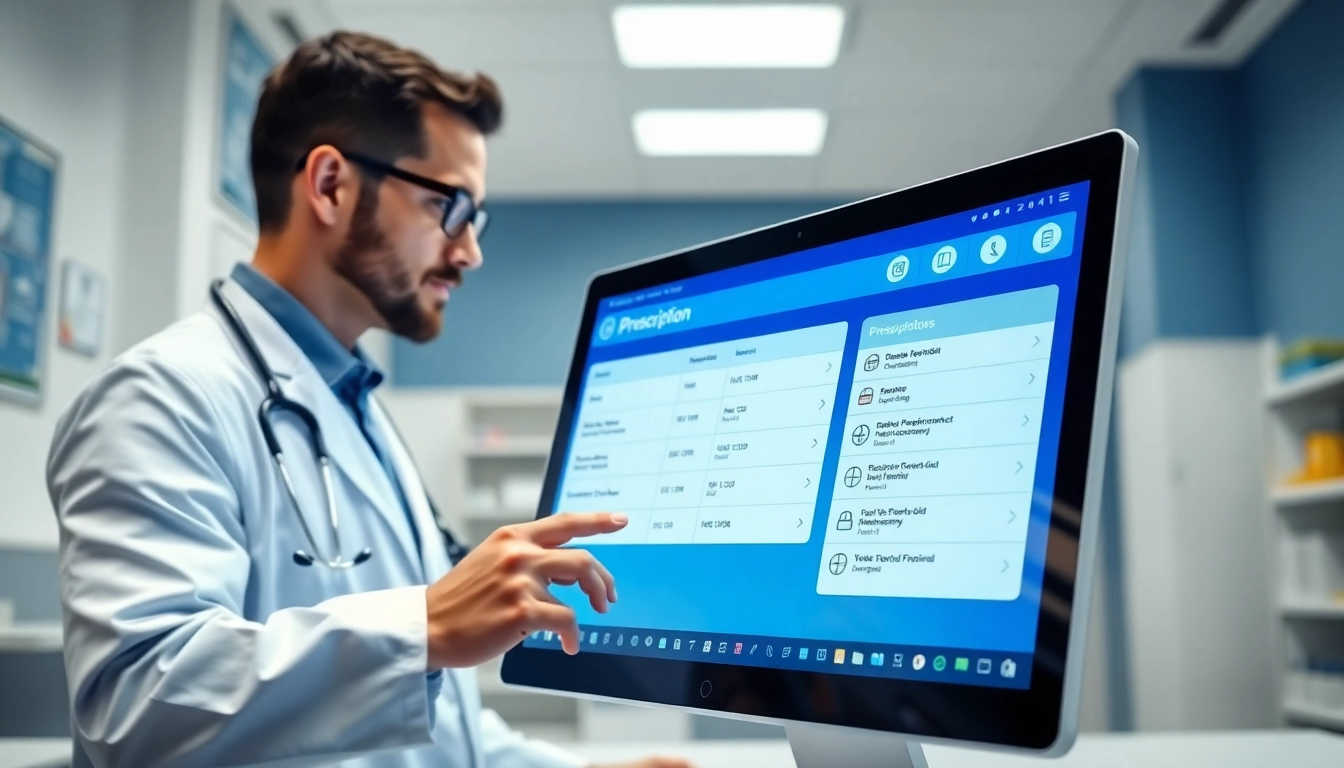Understanding ePrescribing Platforms
In the ever-evolving landscape of healthcare, eprescribing platforms have emerged as a vital tool for improving patient care and streamlining the prescription process. These platforms facilitate the electronic generation, transmission, and filling of prescription orders, making them an integral part of modern healthcare practices. In this article, we will explore what ePrescribing platforms are, their key features, benefits, and challenges associated with their adoption.
What Are ePrescribing Platforms?
ePrescribing platforms are digital tools that enable healthcare providers to create and send prescriptions electronically. Unlike traditional paper prescriptions which can be prone to errors or misinterpretation, ePrescribing systems enhance accuracy by allowing prescriptions to be electronically sent directly to pharmacies. This transition from paper to digital not only helps in reducing prescription errors but also facilitates better communication between healthcare providers and pharmacists.
Key Features of ePrescribing Platforms
- Real-Time Medication History: Most ePrescribing platforms integrate with patient health records, providing real-time access to a patient’s medication history. This helps providers avoid potential drug interactions and better manage patient care.
- Drug Interaction Alerts: Advanced algorithms within these platforms automatically flag any possible drug interactions, ensuring both the prescriber and pharmacist are alerted to avoid serious complications.
- Prescription Tracking: ePrescribing systems often include features for tracking prescriptions, allowing healthcare providers to monitor whether a patient has filled their prescriptions, which can enhance medication adherence.
- Patient Medication Reconciliation: This ensures that all medications a patient is taking are tracked and verified, a critical part of preventing adverse drug reactions.
- User-Friendly Interface: Many ePrescribing solutions are designed with user experience in mind, allowing providers to quickly and efficiently generate prescriptions without extensive training.
Benefits of Implementing ePrescribing Platforms
The benefits of adopting ePrescribing platforms extend beyond mere convenience. Here are some of the most significant advantages:
- Increased Efficiency: The process of writing and transmitting prescriptions is expedited, allowing healthcare providers to focus more on patient care rather than administrative tasks.
- Reduction in Errors: Automated features such as drug interaction checks and legibility enhancements significantly reduce the likelihood of prescription errors, thereby improving patient safety.
- Cost Savings: By reducing errors, improving adherence, and cutting down on the time spent on paperwork, ePrescribing can lead to substantial cost savings for practices and health systems.
- Enhanced Patient Engagement: Many ePrescribing platforms include features that allow patients to manage their prescriptions through mobile apps or web portals, fostering greater patient involvement in their healthcare.
- Streamlined Pharmacy Communication: These platforms help facilitate better communication between prescribers and pharmacies, reducing the wait times for patients and enhancing the overall pharmacy experience.
Challenges in Adopting ePrescribing Platforms
Despite the advantages, several challenges can impede the widespread adoption of ePrescribing platforms. These challenges can be categorized into technological barriers, regulatory considerations, and issues related to user training.
Technological Barriers to Implementation
Many healthcare providers encounter technological challenges when implementing ePrescribing systems. Integrating these solutions with existing electronic health record (EHR) systems can be complex and costly. Additionally, some smaller practices may lack the necessary infrastructure, such as high-speed internet or compatible hardware, to effectively utilize these technologies.
Regulatory Considerations and Compliance
Compliance with various health regulations is a significant consideration for the adoption of ePrescribing platforms. Providers must navigate complex legal requirements regarding patient privacy and security, particularly with HIPAA regulations. Ensuring that the chosen ePrescribing platform complies with these regulations is paramount to avoid legal pitfalls and maintain patient trust.
User Training and Acceptance Issues
Effective utilization of ePrescribing platforms often requires comprehensive training for medical staff. Resistance to change from traditional practices can be a major hurdle, as users may be accustomed to paper-based systems. Comprehensive training programs and ongoing support can enhance user acceptance and ensure that the system is used to its full potential.
Comparison of ePrescribing Platforms
With numerous ePrescribing platforms available in the market, it is imperative to perform a careful evaluation before selecting a system. This evaluation process typically involves assessing platform features, usability, costs, and user satisfaction ratings.
Evaluating Platform Features and Usability
When comparing different ePrescribing platforms, it is vital to assess the specific features that each option offers. Key considerations include the ease of use, integrations with other systems, and support for mobile devices. A user-friendly interface can significantly enhance productivity and reduce the learning curve for healthcare providers.
Cost Analysis of Various ePrescribing Platforms
Cost is a crucial factor when choosing an ePrescribing platform. Analyzing the total cost of ownership, which includes not only the subscription fees but also initial setup costs and ongoing maintenance fees, helps practices make informed decisions. It is also important to consider whether the platform offers better long-term savings through improved efficiencies.
User Reviews and Satisfaction Ratings
Examining user reviews and satisfaction ratings can offer valuable insights into the platform’s effectiveness and user experiences. Platforms that have consistently high ratings often indicate user satisfaction and effective customer support. Such feedback can guide practices toward making well-considered choices that best serve their needs.
Best Practices for Using ePrescribing Platforms
To fully leverage the benefits of ePrescribing platforms, providers should adopt best practices to streamline workflows and improve overall system efficiency.
Tips for Streamlining Workflow
Streamlining workflows when using ePrescribing platforms can significantly improve efficiency. Some actionable tips include:
- Prioritize automation features such as automatic refills and prescription renewals to save time.
- Implement standardized templates for common prescriptions to reduce the time spent on manual entry.
- Train staff on best practices for efficiently navigating the ePrescribing platform to enhance productivity.
Integrating ePrescribing with EMR Systems
Integrating ePrescribing platforms with existing electronic medical record (EMR) systems can minimize disruptions and ensure a seamless flow of information. This integration not only enhances the medication reconciliation process but also improves accessibility to patient data, allowing for informed prescribing decisions.
Ensuring Patient Data Security
Data security is a paramount concern when implementing ePrescribing systems. Practices should ensure that their chosen platform utilizes robust security measures, such as encryption, multi-factor authentication, and regular software updates. Additionally, staff training on data handling and security protocols is essential to mitigate risks associated with patient privacy breaches.
Future Trends in ePrescribing Platforms
As technology continues to revolutionize healthcare, ePrescribing platforms are also evolving. Staying informed about future trends can help practices remain competitive and enhance patient care.
Emerging Technologies Impacting ePrescribing
Artificial intelligence (AI) and machine learning are poised to significantly impact ePrescribing platforms by providing deeper insights into patient data and predictive analytics that can improve outcomes. Future platforms may also incorporate telehealth features to support remote patient care and prescribing efforts, effectively bridging gaps in healthcare access.
Anticipated Changes in Healthcare Regulations
As ePrescribing becomes more widespread, it is important for providers to stay abreast of anticipated regulatory changes. This includes the ongoing evolution of privacy regulations around patient information and medication management practices. Keeping informed can help practices optimize compliance and mitigate potential risks associated with regulatory adjustments.
Patient-Centric Innovations and Care Models
There is a growing movement towards patient-centric care models that engage patients in their health management actively. Future ePrescribing platforms may offer features that empower patients, such as educational resources and feedback mechanisms, thereby promoting adherence to medication regimes and enhancing overall patient care.



